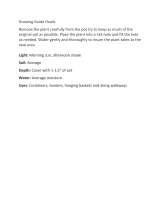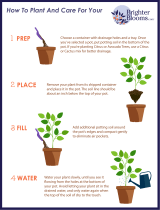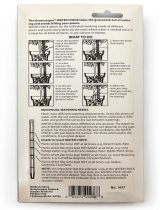Page is loading ...

INTERPRETING YOUR READINGS
1. The numbers from 1 to 9.9 signify increasing wetness and plants can not tolerate either extreme for long. Plants are listed alphabetically by their popular names in the table provided.
Check the name of the plant being tested, and look at the guide number listed in the column immediately to the right. If the meter reading you received is higher than the guide number,
DO NOT WATER. If the number is the same or lower, water as directed. EXAMPLE: You are checking a Dumb Cane (Dieffenbachia.) The meter reads 4, the guide number is 1.You do not water!
2. It is import ant to adhere to the FREQUENCY intervals. The asterisks in the table indicate how often each plant likes water:
*Check once a week
** Check every 4 to 5 days
*** Check every 3 days.
3. SPECIAL WATERING NEEDS are marked with Roman numer als.
I - Spray foliage daily.
II - Never let soil dry out.
III - Keep soil moist but never soggy.
IV - Keep soil wet at all times.
V - Allow soil to
dry between watering.
VI - Soil should remain dry 4–5 days.
VII - Reduce watering during dormant period.
VIII - Water from beneath (in saucer.) Never wet foliage.
HELPFUL TIPS:
Please keep in mind when using the information in the Watering Guide:
1. Pot Size: Small pots dry out faster than large ones, so plants in small pots may need to be checked and watered more frequently.
2. Type of Pot: Soil in cla y pots dries out faster than soil in plastic containers because baked clay is more porous.
3. Light: Plants in full sunlight dry out faster and use more water than those in partial sunlight or indirect light.
4. Location: Plants close to a radiator, vent or heater will dry out more quickly.
5. Overwatering refers to an excessive frequency of watering, not to the amount of water at a given time. The result or overwatering is, inevitably, root rot.
Replacement batteries:
Three (3)
#
357 silver oxide, 1.55 volt
HOW TO USE YOUR METER
1. Press the Power Button to turn the unit on and off.
2. Insert the probe, vertically if possible, into the pot half way between the edge of the cont ainer and the plant stem. In potted plants the depth of penetration will be influenced by the size of
the container; probe deeper in a larger pot, shallower in a smaller one. A good rule of thumb is to probe about 1/2 to 2/3 of the way down from the surface. For containers over 12'' in
diameter, place the probe closer to the stem (about 1⁄3 of the way from the stem to the edge of the pot.)
3. While pushing the probe into the soil you may note that the meter reading varies as the probe moves downward. This is because the soil moisture conditions are not uniform. Certain types of
soil have a tendency to create moistur e pockets, which might give you a false high reading in small areas of the soil. We recommend you take at least two readings in order to confirm your
findings. (Note: probing aerates the soil, which is good for the plant.)
4. Note your meter reading when the LCD display remains constant for about 4 - 6 seconds.
5. Remove the probe from the soil.
6. Wipe the probe clean with a soft cloth or tissue before taking another reading and when testing is completed.
IMPORTANT:
• The meter is designed and constructed for test readings. The probe should not be left in contact with moistur e for extended periods of time. Do not store or leave your meter probe in the soil.
• The meter will turn itself off after about 2 minutes of inactivity. If the meter has tur ned itself off, press the power button to re-start.
The rapitest
®
Digital Moisture Meter is a valuable tool for the hobby gardener.
The meter is ready for use.
USE THE METER ONLY IN SOIL. DO NOT PLACE THE PROBE INTO WATER.
CACTI AND SUCCULENTS:
These plants store water and require less attention than other plants. From March to September, do not allow the soil to dry out. Water when the meter reads 3. From October to February
(dormant period) moderately water every 2–3 weeks, just enough to prevent shriveling. Always use tepid water; cold water can severely shock plants.
LAWNS:
The greatest disservice you can do to your lawn is to water too lightly. Too little water will not accommodate the grass roots. If light watering occurs frequentl y, the roots will start to climb toward
the surface seeking moisture. This resu
lts in burning, particularly during hot weather. The heaviest root concentrations are usually 2 ½ to 3'' below the ground level of your lawn. Therefore, you
should probe about 3'' below the surface. A meter reading of 5 would indicate a satisfactory watering. Provided that your lawn has reasonably good drainage, it is virtually impossible to
over-water.
GARDENS:
Most experts agree that plants should never be allowed to dry to their “wilting point”. The following lists tables for Vegetables and Landscape plants give suggested approximate readings that
indicate that the wilt point is near. Watering is recommended when your test readings coincide with our recommendations. When you do water, water thoroughly. Root depths vary greatly with
different plants and vegetables. When you check the soil moisture level after watering, the meter should read 10. This would indicate sufficient water has seeped down. In soils with poor
drainage (too mu
ch clay) allow about 15 to 30 minutes before checking.
SOIL:
The readings given ar e for the aver age garden loam. Technically, loam is a soil that has characteristics roughly midway between those of sandy soil and clay soil. It is a mixture of sand, clay, silt
and, if fertile, contains a good proportion of organic material (humus). Humus is the name given to all decayed organic matter, whether plant or animal in origin. It is a vital component of
fertile soils. If your soil confor
ms to the this description, use the Wilt Point numbers as indicated. If your soil is more on the sandy side, add one number to the number in the table. If your soil
has a higher percentage of clay, subtract one number from the number in the table.

VEGETABLES
Name Wilt Pt. Name Wilt Pt. Name Wilt Pt. Name Wilt Pt. Name Wilt Pt. Name Wilt Pt.
Artichoke 3-4 Broccoli 2-3 Celery 4-5 Eggplant 3-4 Peppers 2-3 Squash 3-4
Asparagus 3-4 Cabbage 3-4 Chard 3-4 Lettuce 3-4 Potatoes 2-3 Tomatoes 3-4
Beans 2-3 Carrots 2-3 Corn 2-3 Onions 2-3 Radishes 2-3 Turnips 3-4
Beets 3-4 Cauliflower 3-4 Cucumbers 3-4 Peas 2-3 Spinach 3-4
LANDSCAPE PLANTS
N ame Wilt Pt. N ame Wilt Pt. N ame Wilt Pt. N ame Wilt Pt. Name Wilt Pt.
Azaleas 4-5
Chrysanthemums
4-5 Iris 3-4 Primroses 4-5 Tuberous Begonias
4-5
Bamboo 4-5 Daffodils 4-5 Lilies 4-5 Rhododendrons 4-5 Tulips 3-4
Camellias 4-5 Dahlias 4-5 Palms 3-4 Roses 4-5
Cannas 3-4 Fuchsias 4-5 Pines 3-4 Succulents 2-3
Watering Guide and Table
African Violet 3 ** Devilʼs Ivy 4 ** Nasturtium 7 **
Aloe 1 * Dipladenia 1 * VI Natal Palm 6 **
Amary llis 3 ** Dracaena (all) 7 *** Nicodemia 4 *
Anthurium 8 *** l Dumb Cane 1 * VI Nicotinia 7 **
Aralia 4 ** Eas ter Lily 4 ** Norfolk Island Pine 4 **
Arrowhead V
ine 4 ** Echeveria 1 * Oleander 7 **
Asparagus Fern 6 ** III Egyptian Star Cluster 7 ** Orchid 1 ** VI
Azalea 8 *** II Euonymus 1 * VI Painterʼs Palette 8 **
Bamboo Plant 4 ** Fat-Headed Lizzie 4 ** I Panda Plant 1 * V
Babyʼs Tears 6 ** Ferns 6 *** I Parasol Plant 4 * I
Bay Tree 6 ** I Figs, Creeping 7 *** I Parlour Palm 7 **
Begonia Rex 6 ** VI Figs, Fiddle Leaf 1 * VI Passion Flower 7 *** III
Begonia 7 *** III Figs, Weeping 4 ** Peace Lily 8 *** I
Bird of Paradise 3 * Fingernail Plant 7 ** Peperomia 1 **
Billb
ergia 6 *** I Firecracker Plant 7 ** II Philodendron 4 *
Black-Eyed Susan 4 ** III Flame of the Woods 7 ** Piggyback Plant 6 ** III
Bloodleaf 7 *** III Flaming Katy 1 * VI Pigmy Date Palm 8 *** VII
Blue African Lily 7 ** Flowering Maple 7 *** Piles (Aluminum Plant) 6 **
Boston Fern 6 ** Friendship Plant 6 * Plume Flower 7 ** III
Bottlebrush Plant 6 ** Fuchsia 7 *** I Poinsettia 1 * VI
Bougainvillea 8 *** II Gardenia 8 *** I, II Polyscias 6 **
Browallia 3 * Geranium 1 ** VI Pony Tail 1 *
Buddhist Pine 7
** Glory Lily 4 ** Pothos 4 **
Burroʼs Tail 3 *** Gloxinia 7 ** VIII Prayer Plant 7 ** I
Buxus 4 ** Gold-Dust Plant 1 * Primula 7 ** III
Butterfly Flower 8 *** II Grape Ivy 4 ** VI Rabbitʼs Foot Fern 7 **
Caladium 7 ** III Hedera Ivy 6 ** Rubber Plant 4 *
Calceolaria 1 * Heliotrope 7 ** Sensitive Plant 7 *** I
Calla Lily 7 *** VII Hen-and Chicken 1 * Sentry Palm 6 **
Camellia 7 *** I Hibiscus 4 * Shrimp Plant 1 * VI
Cape Cowslip 7 ** Hyacinth 8 *** III, VI Siderasis 1 *
Cape Ivy 1 * Impatiens Walleriana 7 ** V
I Silk Oak 4 *
Cardinal Flower 1 * Inch Plant 1 ** VI Snake Plant 1 * VI
Cast Iron Plant 3 * Jacaranda 6 ** I Snakeskin Plant 4 ** I
Castor Oil Plant 4 ** Jade Plant 1 * VI Spider Plant 7 **
Century Plant 1 * Jacobinia 7 *** Star-of-Bethlehem 7 **
Ceropegia 1 * Japanese Sedge 7 *** III Strawberry Geranium 1 **
Chenille Plant 6 *** I Jasmine 7 *** Sugar Almond Plant 1 * VI
Chinese Evergreen 4 ** Jasmine Plant 8 *** I Swedish Ivy 4 **
Christmas Cactus 6 ** VII Jelly Bean Plant 1 * Sweet Flag 8 *** IV
Christm
as Pepper 7 *** I, III Jerusalem Cherry 3 ** Table Fern 8 **
Chry santhemum 6 ** Jessamine 7 *** Temple Bells 7 **
Cineraria 4 ** Kalanchoe 1 * VI Tillandsia 7 **
Citrus 1 * Kafir Lil y 1 * VI Umbrella Plant
9.9
***
Clerodendrum 7 *** Kangaroo Thorn 6 ** Umbrella Tree 1 ** VI
Coffee Plant 7 *** III Kentia Palm 6 ** Vase Plant 7 **
Coleus 9 *** I Lady Palm 8 ** Veltheimia 7 ***
Columnea 7 *** I Lantana 1 * VI Venus Flytrap
9.9
***
Copperleaf 6 *** I Lipstick Vine 7 ** Verbena 1 *
Coral Berry 7 *** I, III Luck
y Clover 1 * Violet Flame 7 **
Corn Plant 7 *** Maidenhair Fern 6 *** III Vriesia 1 **
Creeping Moss 7 *** Monstera 4 ** Wandering Jew 1 * VI
Crossandra 7 *** I Mosaic Plant 7 ** Wax Plant 4 * I
Croton 7 ** Mosses-in-the-Cradle 7 ** III Wood-Rose 6 *** I
Crown of Thorns 3 * Myrtle 1 * Yesterday, Today, Tomorrow 6 **
Cryptantyhus 1 ** Narcissus 7 ** Zebra Plant 7 ** VII
Cupidʼs Bower 6 ** Nasturtium 7 **
Cyclamen 7 *** VIII Natal Palm 6 **
/






